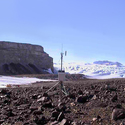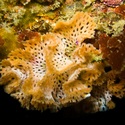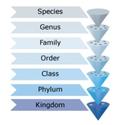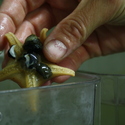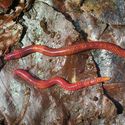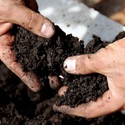To most of us, one earthworm resembles another. Although earthworms do have common characteristics, species1 differ widely in their size, skin colour and in the roles they play in the soil ecosystem2.
Earthworms are found in all but the driest and coldest land areas in the world. There are about 4000 species worldwide. In New Zealand, we have over 200 known species. Most of our earthworms are endemic3 (found nowhere else on Earth). However, the earthworms we are most likely to encounter on rainy footpaths or in garden or pasture soils are introduced species4.
Our earthworm resources move beyond the tiger worm and composting food scraps to delve more deeply into how scientists conduct investigations regarding earthworms and agriculture. We explore living things, using earthworms as an example, and look at their adaptations5 for life in the soil. We also learn about one of our unusual native6 earthworms. Our interactives, videos and teaching activities will give students a new perspective on the ‘lowly’ worm.
Why earthworms?
The appearance of compost systems in many schools, the importance of production agriculture to New Zealand’s economy, the desire to create primary school resources – all of these ideas sprang to mind when it was time for Cath Battersby and Angela Schipper to choose a new topic for the Science Learning Hub. Earthworms seemed to tick all of these boxes.
We’ve seen earthworms struggling across footpaths on rainy winter mornings or ducking for cover when we turn the compost, but what do most of us really know about them? A quick library and internet search provided little more than basic anatomy7 and composting hints.
We were very fortunate to meet Dr Nicole Schon (AgResearch) and Dr Trish Fraser (Plant & Food). Both are actively researching the effects of earthworms in agricultural ecosystems8. It did not take long to realise that earthworms are actually more complex and interesting than we’d first thought!
The science behind earthworms
These are the big science ideas:
- Scientific investigations can run for a few months to a few decades. They can be small and tightly controlled or much larger studies involving real-world conditions9.
- Observation is crucial to a scientist’s work, and observation comes in many forms.
- The characteristics of living things and what makes an earthworm an animal.
- Earthworms live within different niches in the soil and have physical adaptations to suit each niche10.
- The earthworm’s role in the ecosystem is much more than making compost.
- New Zealand has both native and introduced earthworm species.
In addition, this activity investigates the regulations and ethics involved with keeping earthworms in the classroom. We also look at one of history’s most famous scientists, Charles Darwin, and his fascination, appreciation and observations of the lowly worm.
Two lesson plans – for lower primary and upper primary explore these science ideas.
The role of observation in science
Observation became a key part. Our first experience of truly observing earthworms was in Nicole’s lab. She had a number of species, and we were able to see them side by side and watch their movements. Nicole pointed out differences in their appearances and showed us the native O. multiporus, a large bioluminescent specimen11. Our observation skills were further honed when Ross Gray posted us 10 different species of earthworms. (They lived in Angela’s fridge until the video crew arrived!)
Next to observe the earthworms was the Worm Team – a year 4 class in charge of the compost system at a local primary school. The students spent a morning learning about earthworm characteristics and observing how the various species looked and moved. Their comments and questions formed the basis of our teaching and learning activities. The earthworms were then set free in Angela’s garden and patch of backyard bush. We still see each other on occasion!
Teaching and learning: observing earthworms in the 21st century
The Science Learning Hub is all about innovative and media-rich learning opportunities. We wondered how students might best learn about the different physical and ecological characteristics amongst earthworm species. The answer? Wormface – social networking for earthworms! In this activity, students develop a profile for an earthworm species. To do this, they must research its scientific and common names, its physical characteristics and the role it plays in the soil ecosystem. Students record this information in a rather creative and novel12 manner.
Other activities introduce students to some of the big science ideas. They include Living or non-living? (characteristics of living things) and Observing earthworms (observation). Students can engage their literacy skills with Observation in science – three-level reading guide and Caring for earthworms.
Several videos allow students to observe earthworms in a vicarious manner, so if teachers find it difficult to obtain earthworms or are hesitant to have these wonderful earth workers in their classrooms, students don’t have to miss out. Check out Not all the same, NZ native earthworm O. multiporus and Adaptations for life underground and the interactives Earthworms inside and outside.
The citizen science13 project The Great Kiwi Earthworm Survey provides an opportunity to capture information on earthworm abundance and species distribution throughout New Zealand.
- species: (Abbreviation sp. or spp.) A division used in the Linnean system of classification or taxonomy. A group of living organisms that can interbreed to produce viable offspring.
- ecosystem: An interacting system including the biological, physical, and chemical relationships between a community of organisms and the environment they live in.
- endemic: Native to only one location. For example, species endemic to New Zealand naturally occur only in New Zealand but may have been introduced elsewhere in the world.
- introduced species: An animal or plant that has been transferred by humans, either on purpose or by accident, to somewhere it doesn’t live naturally.
- adaptation: A change in the structure or function of something. In biology, a change in a species, as a result of natural selection. Individuals with a particular feature (adaptation) are more likely to survive and reproduce than individuals without this feature.
- native: A species that lives naturally in a country, as opposed to species that have been introduced by the activity of humans.
- anatomy: Structure of biological tissue.
- ecosystem: An interacting system including the biological, physical, and chemical relationships between a community of organisms and the environment they live in.
- condition: An existing state or situation; a mode or state of being.
- niche: The position occupied by an organism in an ecosystem. The niche includes both the organism’s specific physical environment and the role that it plays within the wider ecosystem.
- specimen: An item held in a collection that is preserved to allow study. The item is selected to represent a particular species and is generally a typical individual of that species.
- novel: New or unusual in an interesting way.
- citizen science: Citizen volunteers participate in scientific projects and work in partnership with scientists to answer scientific questions.





